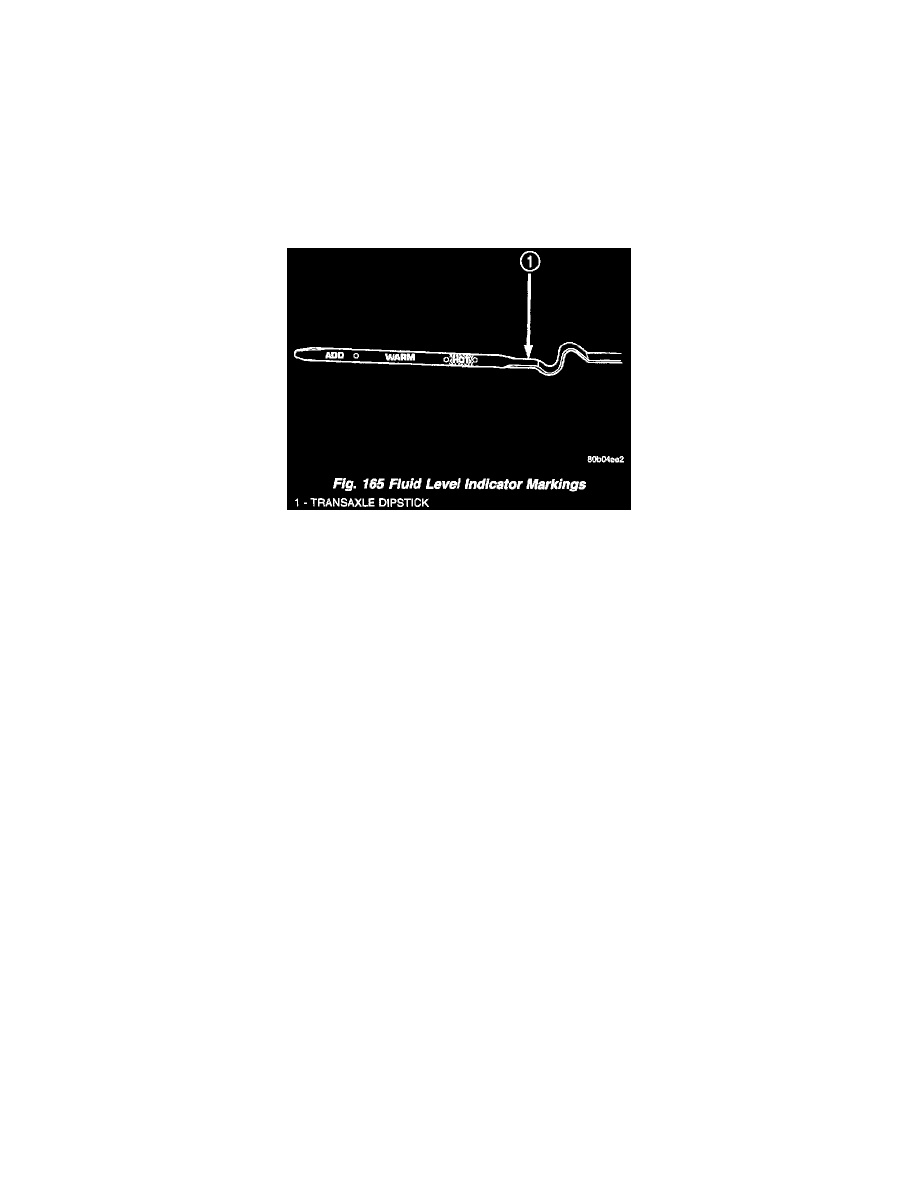Voyager L4-2.4L VIN B (2001)

Fluid - A/T: Service and Repair
31TH
Fluid Level and Condition Check
STANDARD PROCEDURE - FLUID LEVEL AND CONDITION CHECK
NOTE: The transmission and differential sump have a common oil sump with a communicating opening between the two.
FLUID LEVEL CHECK
The torque converter fills in both the P Park and N Neutral positions. Place the selector lever in P Park to be sure that the fluid level check is accurate.
The engine should be running at idle speed for at least one minute, with the vehicle on level ground. This will assure complete oil level stabilization
between differential and transmission. The fluid should be at normal operating temperature (approximately 82°C or 180°F.). The fluid level is correct
if it is in the HOT region (crosshatched area) on the fluid level indicator (Fig. 165).
Low fluid level can cause a variety of conditions because it allows the pump to take in air along with the fluid. As in any hydraulic system, air bubbles
make the fluid spongy, therefore, pressures will be low and build up slowly.
Improper filling can also raise the fluid level too high. When the transaxle has too much fluid, the gears churn up foam and cause the same conditions,
which occur with a low fluid level.
In either case, the air bubbles can cause overheating, fluid oxidation, and varnishing. This can interfere with normal valve, clutch, and servo operation.
Foaming can also result in fluid escaping from the transaxle dipstick where it may be mistaken for a leak.
Along with fluid level, it is important to check the condition of the fluid. When the fluid smells burned, and is contaminated with metal or friction
material particles, a complete transaxle overhaul is needed. Be sure to examine the fluid on the dipstick closely. If there is any doubt about its
condition, drain out a sample for a double check.
FLUID CONDITION
Along with fluid level, it is important to check the condition of the fluid. When the fluid smells burned, and is contaminated with metal or friction
material particles, a complete transaxle recondition is needed. Be sure to examine the fluid on the dipstick closely. If there is any doubt about its
condition, drain out a sample for a double check.
Mopar ATF +4 (Automatic Transmission Fluid Type 9602) when new is red in color. The ATF is dyed red so it can be identified from other fluids
used in the vehicle such as engine oil or antifreeze. The red color is not permanent and is not an indicator of fluid condition. As the vehicle is driven,
the ATF will begin to look darker in color and may eventually become brown. This is normal. ATF +4 also has a unique odor that may change with
age. Consequently, odor and color cannot be used to indicate the fluid condition or the need for a fluid change.
After the fluid has been checked, seat the dipstick fully to seal out water and dirt.
Fluid and Filter Change
STANDARD PROCEDURE - FLUID AND FILTER CHANGE
NOTE: Only fluids of the type labeled Mopar ATF +4. (Automatic Transmission Fluid) Type 9602 should be used. A filter change should be made at
the time of the transmission oil change. The magnet (on the Inside of the oil pan) should also be cleaned with a clean, dry cloth.
NOTE: If the transaxle is disassembled for any reason, the fluid and filter should be changed.
FLUID/FILTER SERVICE (RECOMMENDED)
